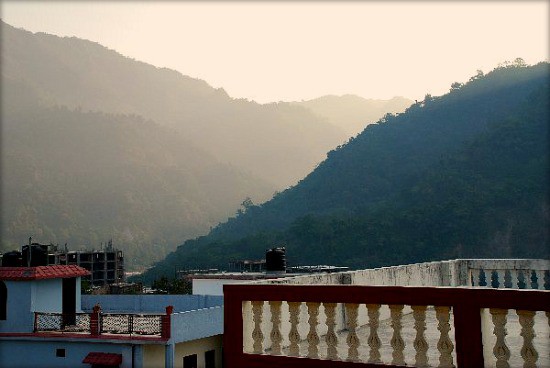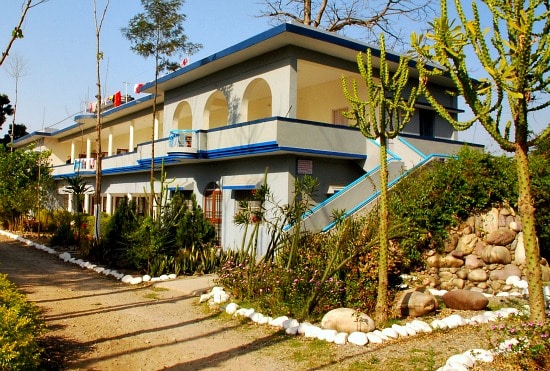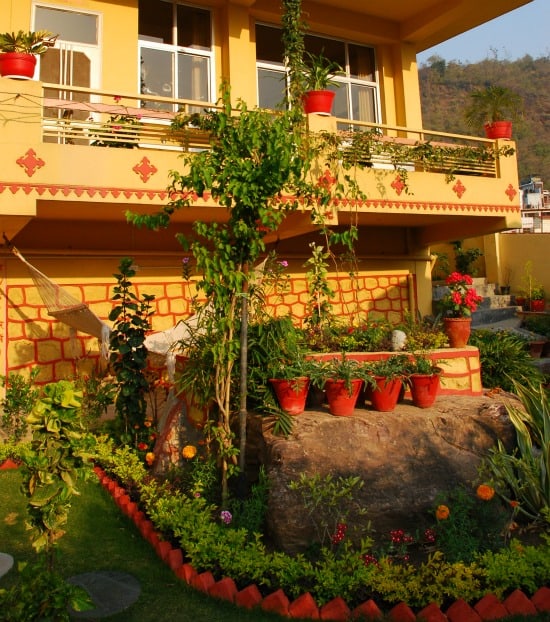
Anand Prakash Yoga Ashram, Rishikesh, India
I love mornings at yoga ashrams in India – it’s a perfect time for meditation or yoga class. The first light of dawn has not begun to rise from behind the Himalayan foothills when the sound of a gong begins to echo through the corridors of Anand Prakash Yoga Ashram in Rishikesh, India. At Aurovalley Ashram, on the outskirts of Haridwar, the buildings are spread out across the ashram’s acres of gardens and you have to wake yourself to be ready in time for 6 am meditation in the silent, white marble meditation hall.
 This is my favourite time of day in India. The intense golden-yellow Indian rises like a benevolent god. In fact, the sun has been worshipped in India since the dawn of time. A feeling of sacred reverence seems to fill the air. In Rishikesh, it’s in the sounds of chants, bells and the song of the Ganges River; at Aurovalley, it’s in the sound of birds, the breeze in the trees and the sight of massive tropical blooms. Huge, crimson hibiscus flowers dangle from trees that line the ashram’s pathways, and whole walls are covered in fuchsia bougainvillea.
This is my favourite time of day in India. The intense golden-yellow Indian rises like a benevolent god. In fact, the sun has been worshipped in India since the dawn of time. A feeling of sacred reverence seems to fill the air. In Rishikesh, it’s in the sounds of chants, bells and the song of the Ganges River; at Aurovalley, it’s in the sound of birds, the breeze in the trees and the sight of massive tropical blooms. Huge, crimson hibiscus flowers dangle from trees that line the ashram’s pathways, and whole walls are covered in fuchsia bougainvillea.
In the film Eat, Pray, Love – based on the best-selling memoir by Elizabeth Gilbert – Julia Roberts’ character travels to Italy to enjoy food, to India to study yoga and to Bali to, eventually, fall in love. In India, Gilbert purportedly stayed in a yoga ashram in Ganeshpuri, a pilgrimage centre outside of Mumbai (Bombay). But there are countless yoga ashrams all over India.

Rishikesh, India
A Place of Respite
Ashrams are places of spiritual retreat. They are not meant to be an escape from life; but a respite from worldly pursuits. They offer spiritual seekers an unencumbered place where they can spend time concentrating solely on the spiritual aspect of life. What is the spiritual aspect of life? It is probably different things to different people, but to me, it’s a chance to be quiet, to spend some time on inner reflection and to think about the bigger questions of life – in other words, “what is my purpose in life,” rather than, “when is that hydro bill due?”
 There is a set daily schedule, which many ashrams expect you to religiously follow. It depends somewhat on whether the ashram caters to Indian or foreign students: the Indian ones tend to be stricter. Anand Prakash is owned and run by Yogi Vishvketu (Vishva), an Indian yoga teacher and his wife Chetana Panwar, from Toronto. Their ashram is usually filled with western students. Aurovalley Ashram is owned and run by Swami Brahmdev (Swamiji), who follows the teachings of Sri Aurobindo. This ashram attracts both Indian and foreign students – many of them from Colombia or Russia because Swamiji regularly travels to those countries. [To read more about Aurovalley Ashram, read A Haven of Peace and Conscious Living.]
There is a set daily schedule, which many ashrams expect you to religiously follow. It depends somewhat on whether the ashram caters to Indian or foreign students: the Indian ones tend to be stricter. Anand Prakash is owned and run by Yogi Vishvketu (Vishva), an Indian yoga teacher and his wife Chetana Panwar, from Toronto. Their ashram is usually filled with western students. Aurovalley Ashram is owned and run by Swami Brahmdev (Swamiji), who follows the teachings of Sri Aurobindo. This ashram attracts both Indian and foreign students – many of them from Colombia or Russia because Swamiji regularly travels to those countries. [To read more about Aurovalley Ashram, read A Haven of Peace and Conscious Living.]
The highlight of the Anand Prakash schedule, for me, is the 6 am yoga class, taught by Vishva in the top-floor yoga hall. The hall has huge picture windows that frame the awe-inspiring site of the sun coming up from behind the Himalayan foothills. In late winter, an invigorating early morning wind rushes down from the mountains – and really does feel like a blast of Shiva energy (Shiva is the god of yoga, and one of the three primary gods in the Hindu pantheon).

Aurovalley Ashram, Rishidwar, India
Relaxing daily routine
At Aurovalley, I love the profound calm of the circular meditation hall, but the day’s highlight for me is satsang, which means, “search for truth.” Every day at 11:30 am, until 1 pm lunchtime, Swamiji sits outside the ashram library, under the mango trees, and answers questions. This is the time-honoured method of spiritual instruction in India.
The day’s flow is dictated by the regular activities – a predictable mix of meditation, yoga, satsang, kirtan (chanting) and meal times. Plus, there is personal time for exercise, exploration, writing, healing (Ayurvedic therapies and massage are usually close at hand) – whatever you choose to pursue. The always-vegetarian food is served in a communal dining hall, and you have to clean your own tin thali (plate) afterward. The food is simple and wholesome, filling and satisfying, though perhaps not to a real foodie.
Breakfast is often some kind of wheat bread – roti, paratha or naan – and fruit or dal (lentils), plus tea. Lunch is usually rice and dal, plus salad or fruit or an Indian dessert such as burfi (a solid milk sweet); and dinner is a whole lot like lunch. The food is only very lightly spiced and does not include garlic or onion; and it is extremely well-washed and purified so that even the most delicate foreign tummy can handle it.

Anand Prakash Yoga Ashram, RIshikesh, India
Accommodation depends on the ashram. In some ashrams, most people sleep in dorms and share washrooms; in others, you can have a private room or share with just one other person, and each room has its own bathroom. The rooms are very simply furnished, but they have everything you need (unless you need a TV, phone and A/C). The simplicity helps to clear your mind. I particularly love the simple, white rooms at Aurovalley Ashram. They were beautifully designed for maximum flow of sunlight and fresh air, and I feel they are very elegant in their simplicity. Solar panels on the roof even provide hot water showers – a treat!
The rules are simple, too: no meat, alcohol, drugs, cigarettes, outside visitors in the rooms. Some also stipulate no sex, even with your spouse (though not usually at the ashrams that cater to foreigners). Previous yoga or mediation experience is usually not required. The most important thing is sincerity.
When I go to the ashram, I take only the bare minimum, which should include all the toiletries you need, a flashlight, a towel, a shawl or sweater (it can be chilly at night in the mountains), loose cotton clothes, preferably Indian-style (Lululemon spandex just doesn’t cut it), flipflops or sandals, sunscreen, mosquito repellent, a hat, long scarf and oil for dry skin; and books, writing materials and mini-laptop. Even ashrams have WiFi these days!
 I know that ashram life is not for everyone, but it sure suits me. I find staying in the ashram to be very healthful and creative, and I make time for it every year.
I know that ashram life is not for everyone, but it sure suits me. I find staying in the ashram to be very healthful and creative, and I make time for it every year.
A few days can do wonders, but a few weeks – even months – can really make a lasting difference in your life.

Mariellen Ward is a freelance travel writer whose personal style is informed by a background in journalism, a dedication to yoga and a passion for sharing the beauty of India’s culture and wisdom with the world. She has traveled for about a year altogether in India and publishes an India travel blog, Breathedreamgo.com. Mariellen also writes for magazines and newspapers.








